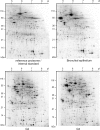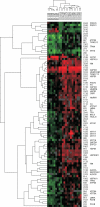Identification of proteomic differences between squamous cell carcinoma of the lung and bronchial epithelium
- PMID: 19176476
- PMCID: PMC2689775
- DOI: 10.1074/mcp.M800422-MCP200
Identification of proteomic differences between squamous cell carcinoma of the lung and bronchial epithelium
Abstract
Proteins that exhibit different expression levels in normal and malignant lung cells are good candidate biomarkers to improve early diagnosis and intervention. We used a quantitative approach and compared the proteome of microdissected cells from normal human bronchial epithelium and squamous cell carcinoma tumors of histopathological grades G2 and G3. DIGE analysis and subsequent MS-based protein identification revealed that 32 non-redundant proteins were differentially regulated between the respective tissue types. These proteins are mainly involved in energy pathways, cell growth or maintenance mechanisms, protein metabolism, and the regulation of DNA and RNA metabolism. The expression of some of these proteins was analyzed by immunohistochemistry using tissue microarrays containing tissue specimen of 55 patients, including normal bronchial epithelium, squamous cell carcinomas, adenocarcinomas, and large cell carcinomas. The results of the immunohistochemical studies correlated with the proteome study data and revealed that particularly HSP47 and a group of cytokeratins (i.e. cytokeratins 6a, 16, and 17) are significantly co-regulated in squamous cell carcinoma. Furthermore cytokeratin 17 showed significantly higher abundance in G2 grade compared with G3 grade squamous cell carcinomas in both the gel-based and the immunohistochemical analysis. Therefore this protein might be used as a marker for stratification between different tumor grades.
Figures






Similar articles
-
[Comparative proteome analysis of human lung squamous cell carcinoma].Zhonghua Zhong Liu Za Zhi. 2006 Apr;28(4):274-9. Zhonghua Zhong Liu Za Zhi. 2006. PMID: 16875628 Chinese.
-
Smoking and cancer-related gene expression in bronchial epithelium and non-small-cell lung cancers.J Pathol. 2006 Oct;210(2):192-204. doi: 10.1002/path.2039. J Pathol. 2006. PMID: 16915569
-
Identification of metastasis associated proteins in human lung squamous carcinoma using two-dimensional difference gel electrophoresis and laser capture microdissection.Lung Cancer. 2009 Jul;65(1):41-8. doi: 10.1016/j.lungcan.2008.10.024. Epub 2008 Dec 5. Lung Cancer. 2009. PMID: 19058872
-
[2-DE profiling and differential analysis of human bronchial epithelial tissues in different stages of carcinogenesis].Ai Zheng. 2004 May;23(5):522-30. Ai Zheng. 2004. PMID: 15142447 Chinese.
-
Increased telomerase activity and elevated hTERT mRNA expression during multistage carcinogenesis of squamous cell carcinoma of the lung.Cancer. 2001 Aug 15;92(4):849-55. doi: 10.1002/1097-0142(20010815)92:4<849::aid-cncr1392>3.0.co;2-4. Cancer. 2001. PMID: 11550157
Cited by
-
Leaf Proteome Analysis Reveals Prospective Drought and Heat Stress Response Mechanisms in Soybean.Biomed Res Int. 2016;2016:6021047. doi: 10.1155/2016/6021047. Epub 2016 Mar 13. Biomed Res Int. 2016. PMID: 27034942 Free PMC article.
-
How do glycolytic enzymes favour cancer cell proliferation by nonmetabolic functions?Oncogene. 2015 Jul;34(29):3751-9. doi: 10.1038/onc.2014.320. Epub 2014 Sep 29. Oncogene. 2015. PMID: 25263450 Review.
-
The proteomic signature of insulin-resistant human skeletal muscle reveals increased glycolytic and decreased mitochondrial enzymes.Diabetologia. 2012 Apr;55(4):1114-27. doi: 10.1007/s00125-012-2456-x. Epub 2012 Jan 27. Diabetologia. 2012. PMID: 22282162
-
A Quantitative Proteomics View on the Function of Qfhb1, a Major QTL for Fusarium Head Blight Resistance in Wheat.Pathogens. 2018 Jun 22;7(3):58. doi: 10.3390/pathogens7030058. Pathogens. 2018. PMID: 29932155 Free PMC article.
-
The value of proteomics in lung cancer.Ann Transl Med. 2015 Mar;3(3):29. doi: 10.3978/j.issn.2305-5839.2015.01.10. Ann Transl Med. 2015. PMID: 25815290 Free PMC article.
References
-
- Boyle, P., and Ferlay, J. ( 2005) Cancer incidence and mortality in Europe, 2004. Ann. Oncol. 16, 481–488 - PubMed
-
- Jemal, A., Murray, T., Ward, E., Samuels, A., Tiwari, R. C., Ghafoor, A., Feuer, E. J., and Thun, M. J. ( 2005) Cancer Statistics, 2005. CA Cancer J. Clin. 55, 10–30 - PubMed
-
- Basbaum, C., and Jany, B. ( 1990) Plasticity in the airway epithelium. Am. J. Physiol. 259, L38–L46 - PubMed
-
- Patz, E. F., Jr., Rossi, S., Harpole, D. H., Jr., Herndon, J. E., and Goodman, P. C. ( 2000) Correlation of tumor size and survival in patients with stage IA non-small cell lung cancer. Chest 117, 1568–1571 - PubMed
Publication types
MeSH terms
Substances
LinkOut - more resources
Full Text Sources
Other Literature Sources
Medical
Miscellaneous

